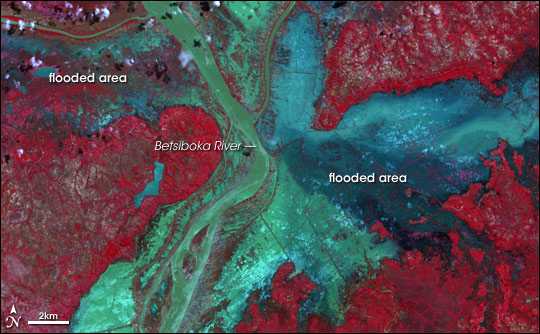

Knowing What’s Normal | |||
Because of MODIS’ near-daily observations of every spot on Earth, Brakenridge has the opportunity to construct baseline maps of watersheds when they are not flooded. “It’s important to have a standard reference so that when we map a flood, we don’t mistakenly include areas that are normally under water, such as lakes, reservoirs, or wetlands,” he explains. [See Sidebar: Monitoring Wetlands.] Brakenridge is also interested in documenting another normal reference: the normal flood. One thing you notice when you look through the Dartmouth Flood Observatory’s archives is that there are places on Earth—for example, northern India, China, and Bangladesh—where large-scale flooding is surprisingly regular. As more people crowd into flood-prone areas the normal cycles of flooding can begin to be seen as dangerous or unusual. “We don’t want to make a big fuss about major flooding along a particular river when, in fact, it floods every year,” he says. |
|||
 |

Sharing What They KnowMonitoring the floods and creating the global atlas of flood hazards is only half of the Dartmouth Flood Observatory’s mission. They also want to get their information into the hands of disaster management planners and relief agency workers as quickly as they can when a disastrous flood occurs. “Within large parts of Africa, Asia, and South America, there are no flood warning systems,” says Brakenridge. Getting the word out to aid organizations that this online resource is available to them, however, wasn’t an easy process. Brakenridge has now teamed up with the AlertNet Website to help get flood maps to the international aid community. Established by the Reuters Foundation, AlertNet provides news and information to international humanitarian aid and disaster relief organizations. |
Monsoon rains bring floods to low-lying Bangladesh every summer. Although the amount of land covered is large and the damage is often severe, annual flooding is the normal behavior of the Ganges River Delta. This graph shows how the amount of standing water across the region peaks and ebbs from season to season. The surface area covered by standing water was measured by the QuikSCAT satellite from mid-1999 until the end of 2004. (Graph courtesy Dartmouth Flood Observatory) | |
 | |||
Even though satellite data are freely available from NASA, humanitarian relief agencies often don’t have the expertise or resources to directly download and process data. AlertNet presents satellite data as imagery that is easy to understand and more meaningful to emergency managers. “It has taken a long time for the international aid community to recognize the value of satellite imagery, but this is beginning to change because of services such as AlertNet,” says Oliver Greening, a data visualizer with ESYS Consulting who has been funded by the European Space Agency to produce satellite images for AlertNet. Brakenridge hopes that making flood maps publicly available online in near-real time will overcome technological, financial, and infrastructure barriers in developing countries that prevent aid agencies there from taking advantage of satellite data. |
Satellites observe the world globally, enabling relief workers to monitor floods in remote areas, such as Madagascar’s Betsiboka River. This image shows flood water (turquoise) spilling out from the river’s channel on March 10, 2004. Vegetated areas are red and bare ground appears tan. (Image by Jesse Allen based on data provided the NASA/GSFC/MITI/ERSDAC/JAROS ASTER Science Team) | ||